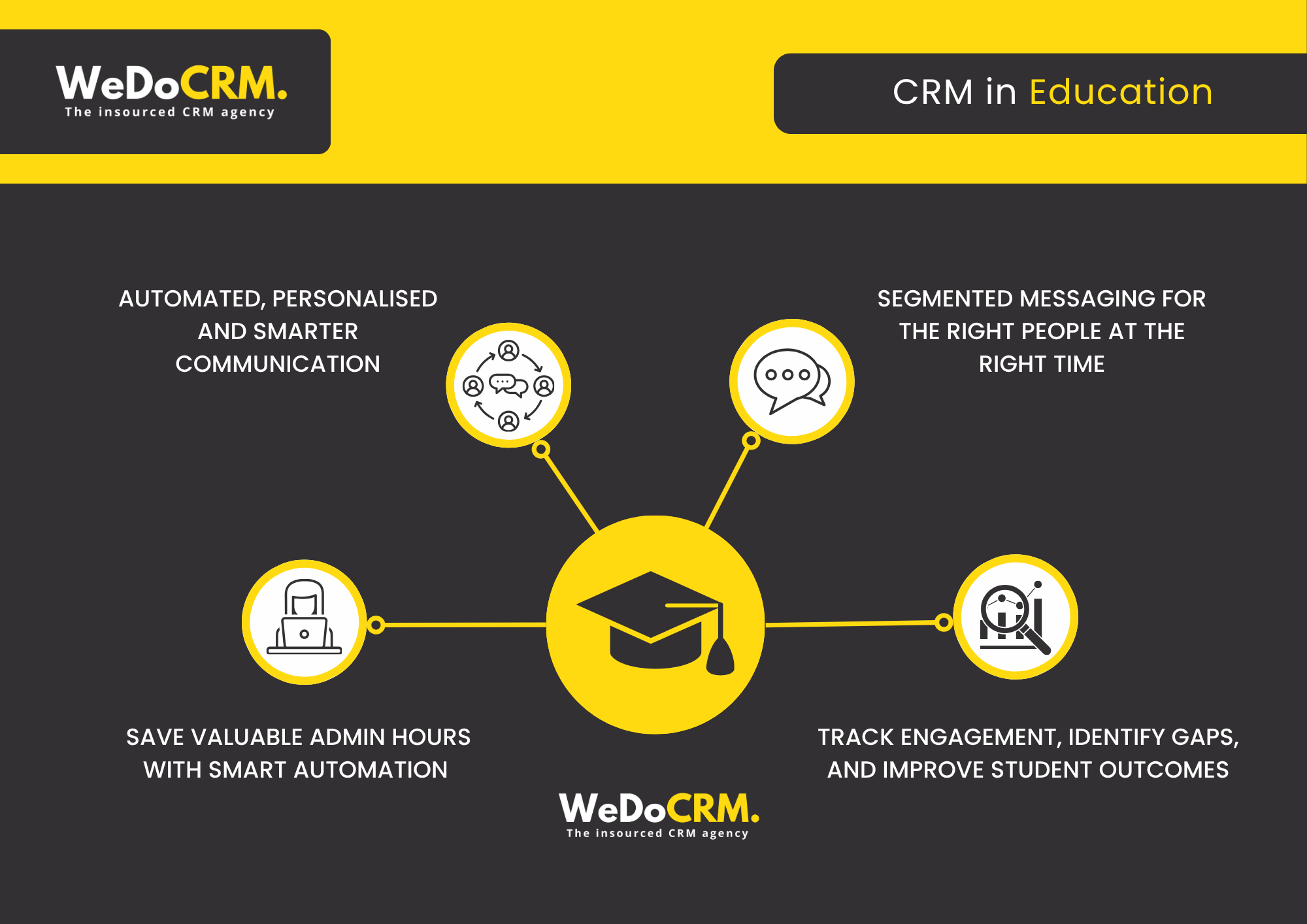We’ve recently been speaking with admissions, student services, marketing, and alumni teams across various universities and colleges, and two key challenges keep coming up that are holding institutions back. One challenge is that some institutions rely heavily on spreadsheets, manual updates, and disconnected systems to manage all student information, and the other challenge is that other institutions have the technology in place, but it’s not being used correctly; the tools exist, but the day-to-day processes don’t fully leverage them.
It’s so easy to chat about what tech can actually do, but the real stories are how it’s applied each day, from admissions, follow-ups, student check-ins, alumni outreach and every other interaction in between. These touchpoints influence the student experience, yet fragmented systems or underused tech create so much friction and annoyance for both staff and students.
We’ve partnered with DotDigital to dig into what’s really working in education — the biggest pain points and how institutions are actually solving them. We looked at a few institutions that have actually fixed these issues. Not with massive tech projects, but simply by connecting Martech tools that should’ve been connected all along.
If any of these challenges sound familiar, this one’s worth a read. The global higher education CRM market is expected to grow at a steady 9.1% CAGR from 2024 to 2030 — a clear sign that institutions are investing in smarter, more connected ways to engage students and leverage AI. In this blog, we explore the most common issues we hear from admissions, student services, marketing, and alumni teams — and share practical solutions that are already making a real difference.
Paint Point 1: Spreadsheets to CRM Platforms
When universities or colleges first start managing student enquiries or alumni records, spreadsheets make perfect sense. They’re simple, familiar, and (best of all) free — especially with tools like Google Sheets.
For a while, they work brilliantly. But as student numbers grow and processes become more complex, what once felt flexible starts to feel… fragile. Spreadsheets just don’t have the features of dedicated CRM software, and here’s why.
Spreadsheets Are Multiplying Faster Than Enrolments
What started as a single clean document is now ten versions with different tabs, formats, and owners. Admissions has one file. Marketing has another. Student services keeps a “master list” that no one else can find. If you are spending your time looking for data rather than supporting your students, that is your clear sign that it’s time to implement a centralised system. A CRM platform keeps everything organised and accessible to everyone who needs it.
Data Loss, Corrupted Files, and No Single Source of Truth
The more spreadsheets you have, the harder it is to know which one is “the right one.”
Files get saved on desktops, shared drives, or someone’s personal folder. Data gets duplicated. Occasionally, it gets lost entirely.
And while shared cloud documents help, they can’t provide what a CRM does — secure, trackable, backed-up data with clear ownership and permissions. It’s not just about convenience and it being time saving, it’s actually more of a way to protect student information and maintain compliance with GDPR.
Spreadsheets Cause Chaos with Teams
The moment two people try to update the same cell, something breaks. Admissions might update an enquiry status while marketing is sending a follow-up email — and neither knows what the other is doing. It is cringe when people get flooded with emails from a company that shows there’s no internal communication.
A CRM platform, on the other hand, connects those dots! When someone updates a student record, it updates everywhere. When a prospect clicks a campaign link, admissions can see it instantly. It’s now more of a flow and a great collaboration without the confusion.
If your institution is at the stage where spreadsheets are becoming more of a burden than a benefit, that’s actually a good sign — it means you’ve grown. Now it’s time to match that growth with the right systems. You can read more about why you should migrate from spreadsheets in our article here – Reasons To Move from Spreadsheets to a CRM Platform.
Pain Point 2: Making the Tech You Already Have Better
Now, for the other major pain point, this is for institutions that already have the technology or a CRM platform but aren’t seeing the results they expected. We see this more often than not. The technology is there, the licences are paid for, the system technically “works”… but staff aren’t using it, or they’re using it in a way that doesn’t add real value.
Often, this comes down to poor integration; the CRM platform may not connect properly with your student information system (SIS), learning management system (LMS), or marketing tools.

Maybe the setup was rushed, the platform feels too complicated, or it was built around someone else’s processes, not yours. The truth is, the CRM itself isn’t the problem; it’s how it’s being used. If staff find the system confusing or it doesn’t align with how they work, they simply won’t use it. Data gets patchy, reporting becomes unreliable, and leadership loses confidence in the platform.
What Helps Support CRM Success in Education
A CRM platform is only as powerful as how you use it. Here are our thoughts on the key capabilities that make the real difference:
Personalisation
Tailor communications based on course interest, application stage, and student profile.
Automation
Handle routine tasks like acknowledgement emails, application reminders, and follow-ups automatically. This frees staff to focus on meaningful conversations.
Data Cleansing
Regular maintenance to remove duplicates, standardise formats, and update outdated information. Clean data means better decisions and staff who trust the system.
Behaviour-Based Journeys
Respond to what students actually do. If they download a brochure, send related content. If they don’t complete an application, trigger a helpful reminder.
Integration
Connect your CRM with your SIS, LMS, email platforms, and other systems so data flows automatically and teams see the complete picture.
How WeDoCRM Can Help
A good CRM platform helps schools and universities connect with students in a more personal and meaningful way. Here at WeDoCRM, we can help you create experiences that feel personal, keep things running smoothly behind the scenes, and support students from their first day all the way to alumni life.
We do this by using personalisation to tailor communications to each student, automation to handle routine tasks like follow-ups and reminders, and behaviour-based journeys to guide students through admissions, onboarding, and beyond.
The good news is you don’t need a new platform to fix this. Here’s what we’ve seen work across higher-ed institutions:
| Common Issue | WeDoCRM Recommends |
| Staff aren’t logging activity | Simplify the CRM interface. Strip out unnecessary fields and surface only what matters to each user (e.g. quick actions for admissions, dashboards for marketing). |
| Data feels unreliable | Run a data audit. Clean duplicates, standardise naming conventions, and connect your CRM with your core systems (SIS, LMS, email). Integrations save hours and restore trust in the data. |
| Marketing and admissions don’t align | Build shared dashboards and workflows that connect both teams. When marketing knows who’s applied, and admissions knows where a lead came from, everything runs smoother. |
| Reports don’t show real insight | Tailor dashboards by role — admissions, marketing, alumni — so each team sees only what’s relevant and actionable. Real insight = faster decisions. |
| No one “owns” the CRM | Create a CRM steering group. A cross-department team that meets monthly can champion best practices, monitor usage, and ensure alignment. |
The Answers Lie in our Education Whitepaper
The biggest gains we have seen in Education come when you connect your CRM to everything else. Incorporating marketing automation tools, syncing your LMS to track student progress and connect alumni and fundraising systems, and all of them talk to each other.
Maybe your biggest challenge is responding to leads fast enough. Or your data sits in silos across departments.
Whatever the case, start by getting clear on what’s not working — and define what great could look like.
In our latest whitepaper with Dotdigital, Unlocking the Power of CRM in Education, we explored exactly these challenges and how institutions are solving them.
It features real-world examples from universities like Utah State and Oxford Saïd Business School, which’ve overcome the same issues from low adoption to disconnected data by focusing on strategy, integration, and collaboration rather than just technology.
Here at WeDoCRM, we help education providers get their CRM in order. We would love to talk to you and brainstorm some ideas on your tech stack. Get in touch with us. We look forward to hearing from you!






